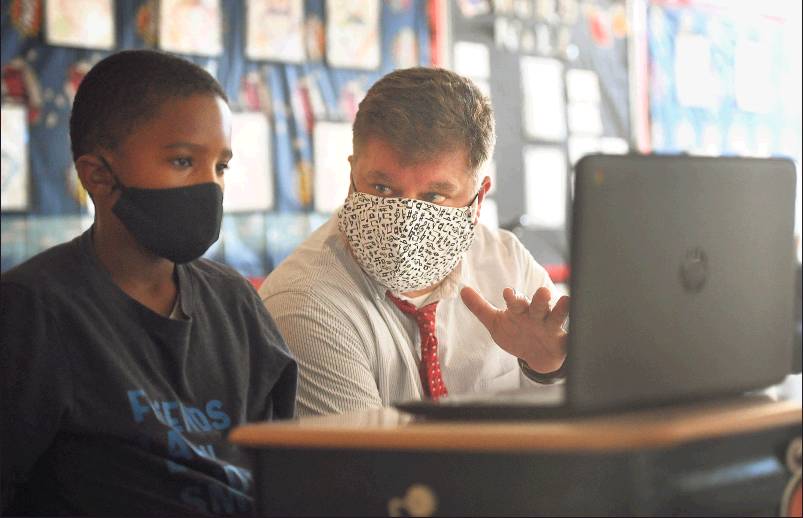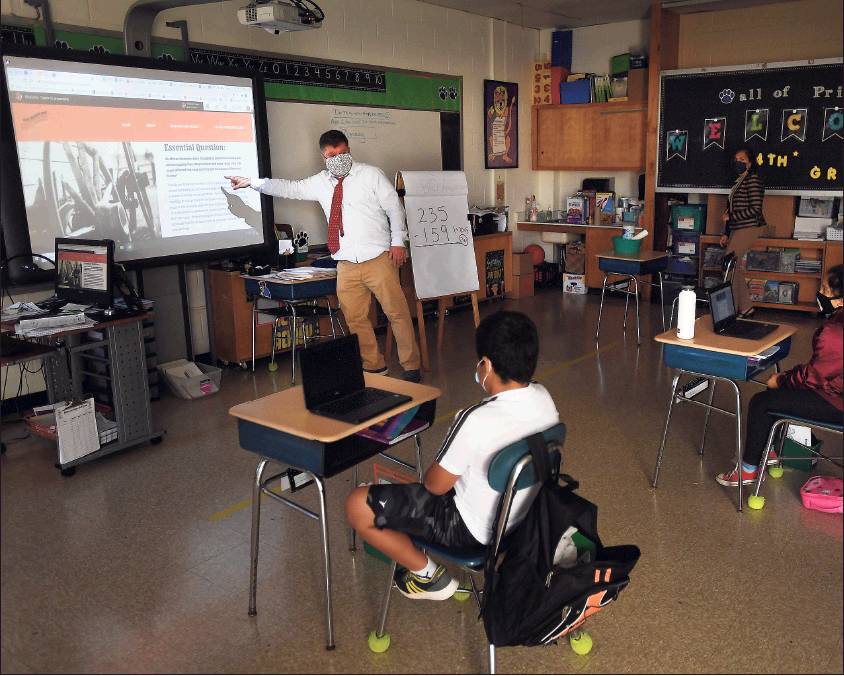Teaching African American history through music
Blues and Beyond program examines intertwining musical, social and political histories from the 1600s through modern day
By Ignacio Laguarda
STAMFORD — In the middle of a history lesson to fourth grade students, Adam Taylor broke into a rendition of an old song sung by slaves as they worked the fields.
“Be my woman and I’ll be your man, if you promise me you’ll be my wife, I will love you the rest of my life,” sang Taylor, an accomplished singer and songwriter, through a videoconferencing platform to a class at Stillmeadow Elementary School on Thursday morning.
Bringing such songs to life for students is at the heart of a program being piloted in the Stamford Public Schools called The Blues and Beyond.
The concept of the 12-week course is to teach African-American history through music. The course, provided through Stamford’s music department, also traces musical history all the way to modern times, identifying threads that tie traditional African-American music to artists of today such as Beyonce and others.
“By doing this program, we’re trying to avoid Black American history being taught just for one month of the year. We’re trying to spread it out throughout the year.”
Eric Finland, a classical and jazz pianist who first conceived of Blues and Beyond and serves as its director
Stamford is the first district in the country to try the program, which is currently in five schools: Dolan Middle School, Cloonan Middle School, Stark Elementary School, Northeast Elementary School and Stillmeadow.
The presentation to students on Thursday involved a video narrated by Taylor. Throughout, he would pause the video and speak to the students through a webinar platform, sometimes singing songs that would illustrate the lesson. Working in conjunction with Taylor was Stamford music teacher Darren Stec, who facilitated the lesson for kids live in the classroom.
Whenever the video was stopped, students were presented with questions based off what was just shown. The class on Thursday covered the transatlantic slave trade, Jim Crow laws, the Underground Railroad, the Tulsa Massacre of 1921 and the origin of Juneteenth.
Along the way, students were taught about the origins of ragtime, spirituals and other musical forms.
Eric Finland, a classical and jazz pianist who first conceived of the program and serves as its director, said his hope is to expand The Blues and Beyond to more schools and at the same time grow the curriculum of African-American history in schools.
“By doing this program, we’re trying to avoid Black American history being taught just for one month of the year,” he said. “We’re trying to spread it out throughout the year.”
Hendrix Niemann, the business manager for the pilot program, said there have been inquiries from other public schools.
“We’ll go wherever the interest lies,” he said.
Finland, who holds a bachelor of fine arts in music performance from Berklee College of Music, was also teaching students virtually on Thursday alongside Taylor.
He began the class by sharing the “essential question” for the course: “As African Americans have struggled to overcome injustice and achieve equality, their story has been told many ways. How has music reflected that story and changed the course of American history?”
Finland hopes to fill in gaps where public education historically has neglected portions of American history.
One example is the Tulsa Massacre, which recently was the subject of some attention after the HBO television show “Watchmen” depicted the incident, in which a prosperous Black community was destroyed, leaving 10,000 Black people homeless and more than 200 dead.
Taylor, a Black man, said he didn’t know about the historical event until he was in his 30s.
“As a 33-year-old person and someone who went to college, I didn’t learn about it ... until my third year of college,” he said. “So I went through all of elementary, middle and high school and the first years of college never even knowing anything about the Tulsa Massacre.”
One of the 10 or so questions presented to students on Thursday was, “Why do you think that many students never learned about the Tulsa Massacre in school, up until recently?”
Students had a chance to ask questions at the end of the class. One asked, “How did black people end up as slaves and not white people?” Another asked “Why couldn’t white people do work themselves?”
Finland answered the second question by saying, “Why did they have to so cruelly steal these human beings and rip them from their homeland? Because it was free and it was cheap and it was easier for them to do it than themselves. It was a very cruel way to get a lot of things done very quickly and as cheaply as possible.”
Stec, the classroom teacher for the Stillmeadow class, said the course has been a “godsend” during a school year in which traditional musical instrument instruction has been postponed due to risks related to the spread of COVID-19.
At the end of the program, each student will be tasked with writing a blues song that they will perform. Select songs will be set to music and recorded.
Stec has challenged his students to write about something that upsets them when coming up with the song.
So far, he said, about 90 percent of the lyrics from the students have been about a sibling who annoys them.
Finland said The Blues and Beyond originally started off as a musical that traced the history of music from the 1600s to modern day. It eventually morphed into the curriculum being presented to Stamford students today.
For Finland, music and history go hand-in-hand, a concept he hopes to pass along through the program.
“You can’t study jazz if you don’t know about the history of African Americans in the United States,” he said. ignacio.laguarda@stamfordadvocate.com

